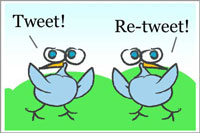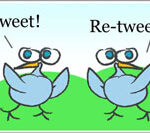How to get your targets to notice your tweets
16 June 2011 By Northern Lights

 When you organise an event, if you want someone really important to be there, you wouldn’t just rely on your generic invitation? Of course not, you’d at least write a tailored introductory email explaining the importance of their attendance and what’s specifically ‘in it for them’ then follow up with them to make sure they can make it.
When you organise an event, if you want someone really important to be there, you wouldn’t just rely on your generic invitation? Of course not, you’d at least write a tailored introductory email explaining the importance of their attendance and what’s specifically ‘in it for them’ then follow up with them to make sure they can make it.
Tweets are the same – if you’ve got something that you want people to respond to, like a new blog or entries for your awards, you need more than a general tweet to your followers en masse.
Here are some of the tips that have worked for us or our clients.
1. @name to the people you want a response from
Journalists and busy business people are increasingly ignoring emails but pick up on tweets that @mention them – if it’s from a known and trusted source. This is partly because people want to be seen to be up to date and on top of tweets, but also because they want their followers to see that someone’s mentioned them. As long as you are credible, genuine and don’t ‘spam’ people with irrelevant information, flattery will get you everywhere on Twitter.
2. Make your tweet personal
As with any other form of communication, it’s about knowing your recipient and tailoring your message to them. In some instances if it’s an individual or organisation you’re not working directly with and don’t want to appear ‘pushy’ with, you may just @mention them and say ‘thought you might be interested in this blog on XXX – would appreciate your views’. If it’s a journalist who is likely to be covering a new policy announcement, you might say ‘if you need commentators on the XXX Government Review, our Chief Exec is available – read her blog here XXX’.
We had a good example of this recently. We mentioned an article by FT journalist in Bradford University School of Management’s digest, then tweeted the various people who had been mentioned in the digest. This generated responses and conversations.
3. Be selective in your tweets
But we are selective about who we send these tailored tweets to. If it’s every journalist you follow or lots of competing business people, they’ll see that you’re not being very selective and it won’t feel very personal or flattering! If it’s an exclusive or something confidential/under embargo, we use private direct messaging (DM) instead of an @mention.
We’ve also found that tailoring tweets with different key words helps the tweet to be found through searches. For example, some people will be most interested in the fact that a certain speaker is at your event and others will be more bothered about one of the workshop topics so a few different tweets focusing on different angles helps attract different people.
